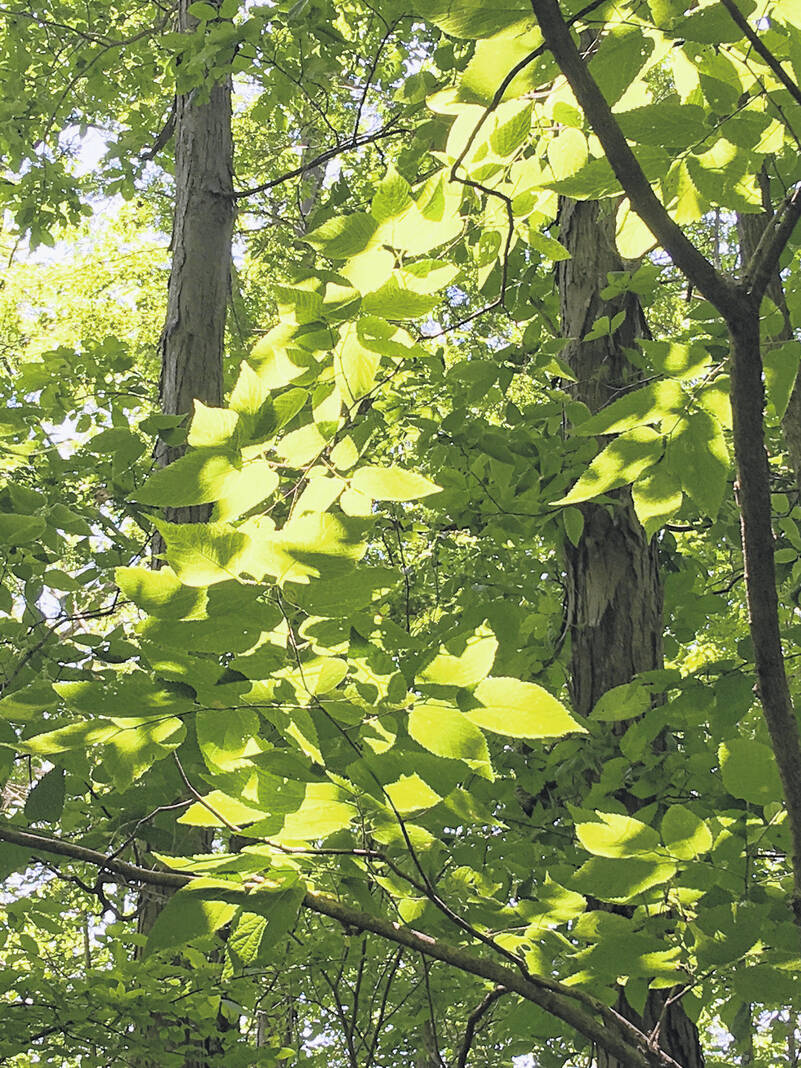

The author and his wife visited a preserved elm tree in Indiana.
Photo by Gosia Nuwer
Near Darke
By Hank Nuwer
Once upon a time, every hamlet in the American Midwest had an Elm Street.
But around 1930, a killer stalked our neighborhoods.
The homicidal maniac wasn’t Freddy Krueger in fedora and red and green sweater.
No, this Nightmare on Elm Street was a blight hailing overseas from the Netherlands. It took hold in the Netherlands after World War One.
Similar invasions of shade trees also destroyed that king of the forest, the American chestnut tree, and now, the ash tree. (I was blessed 30 years ago to visit last stands of American chestnut trees in Wisconsin and Minnesota for a magazine assignment).
As a boy growing up on my block in suburban Buffalo, New York, around 1963, crews of men bearing chainsaws cut every tree. An estimated 10,000 trees infected by Dutch Elm Disease fell in Buffalo by 1965.
My father dug up a blue spruce on our family farm to replace the elm.
I loved our elm tree. Its massive roots pulverized the sidewalk in front of our house.
Turns out the elm’s spreading roots were part of the problem.
In a 1968 editorial, “American Elm May Be No More,” the Greenville Advocate explained why local elms similarly were winking out.
“Bark beetles generally have been blamed as carriers of the disease, as they are,” the Advocate said.
“Infected trees are able to contaminate others by a peculiarity of the elm, which is to attach its roots to others of the species underground. A sap transfusion from one tree to the next carries cells of the fungus with it.”
If you were born after 1972, you probably never saw an elm.
Last Sunday, Gosia and I were excited to spot a small lone elm in an Indiana forest preserve a mere 20 miles from the Ohio-Indiana stateline.
To get there, we started from IN State Road 28 at the Dollar Store. We drove through Ridgeville and then we headed south a short distance on IN route 1.
You’ll clock 23 miles all told from start to finish.
If you have time and energy for a one-hour hike, consider visiting the McVey Memorial Forest Trust after downloading a map on the Internet: https://fortheland.org/mcvey/
The tree is temporarily unreachable from the pretty entrance to the preserve. The red trail starting at the entrance is closed for repairs. However, the picnic area is open and has benches beneath a pavilion if you wish to bring a picnic basket.
After inspecting the entrance, my wife Gosia and I drove a short way to the tiny parking lot on Indiana W. 700 North.
We hiked to the elm in 20 minutes over level, easy terrain. The elm tree in the McVey Memorial Forest is clearly marked with an informational placard. You cannot miss it if you pay attention to the placards.
The narrow path is flanked by underbrush and many forest trees last harvested in 1951.
This elm’s isolation from its own kind helped it survive disease-free. I recognized the elm’s spongy bark and the double serrated edges on the leaves.
While the elm is not so tall, trees of other species are of majestic height and impressive girth. We also admired shagbark hickory trees, a magnificent Chinquapin oak, hackberry trees, and many more species.
A trail spur leading away from the main path was closed, but we intend to go back after repairs are made. A placard noted that on a small hill is a large basswood in which wild bees live and work.
Birds were abundant. You’ll walk accompanied by the whack-whack-whack of pileated woodpeckers. There also are hairy woodpeckers, mourning doves, nuthatches and more.
Our destination reminded me of my 2016 visit with Gosia to the Bialowieza Forest National Park straddling eastern Poland and western Belarus. That reserve is more than 1,000 years old and is Europe’s last outgrowth of primeval forest.
As I write, according to Forest Pathology journal, European researchers are seeing if it may be possible to regenerate elms in the Bialowieza preserve.
When we visited the Bialowieza preserve, we attended a guided lecture on how medieval bee raisers raised wild bees in the boughs of giant trees like the Hoosier preserve’s basswood.
Honey harvesters climbed the trees and sometimes found giant bears awaiting them.
The nearly 300-acre preserve was the 1968 gift to future generations bequeathed by the now deceased Edna, Lewis and Charles McVey.
It had been a working family farm for many generations.
The preserve has a few rules. Pack out your trash. Disturb nothing.
Next Sunday, we’ll go back to hike again. First, we’ll pause in Ridgeville for breakfast at the American Legion Post.
This time we will take the trail clear to the Mississinewa River.
Hank Nuwer is an author, columnist and playwright. He and wife Gosia live on the Indiana side of the Union City state line. Viewpoints expressed in the article are the work of the author. The Daily Advocate does not endorse these viewpoints or the independent activities of the author.




